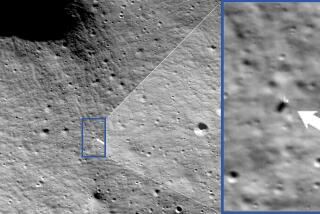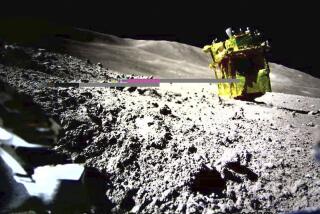Philae’s location on comet still a mystery, but answer may come soon
- Share via
The Philae lander’s precise location remains a mystery more than a week after it touched down on a comet, but now science detectives say they are getting closer to figuring out exactly where it ended up.
Researchers have narrowed the lander’s final resting spot to a 350 meter stretch (1,150 feet) just outside a basin on the rubber-duck-shaped-comet’s “head,” or perhaps, to a spot within the basin.
To get to this conclusion, the scientists used data collected by the CONSERT experiment, which was originally designed to get a sort of ultrasound reading on the comet’s nucleus.
Infographic: Rosetta probe’s mission, step-by-step
It took two spacecraft to pull off the experiment. The radio waves were generated by the Rosetta orbiter and received by Philae. The waves traveled through the nucleus to get to the lander and were altered by what they encountered in the comet’s icy heart. The lander collected the data, and then sent it back to the orbiter, which in turn sent it to Earth.
As it turns out, CONSERT’s data can also provide clues about where the lander is on the comet. Scientists used CONSERT to measure the distance between Philae and Rosetta during periods when the radio waves went directly from orbiter to lander. They were also able to make measurements when the waves went through the core.
Using that information, they have narrowed the lander’s position to two areas, but the answer depends on which model of the comet’s underlying shape they use.
The next step is to use OSIRIS, a high-resolution camera instrument on Rosetta to look for the lander in the areas where CONSERT predicted it might be.
Philae made a total of three landings on the comet. The first was in a pre-selected site known as Agilkia that had the advantage of being relatively boulder free, and offering the lander at least six hours of sunlight a day to power its battery.
But when two harpoons designed to tether the lander to the comet failed to deploy properly, Philae bounced twice before settling,
In its new home, Philae is getting just 1.5 hours of sunlight a day, not enough to keep its battery charged, so the lander went to sleep just 64 hours after it landed. However, scientists are hopeful that as the comet moves closer to the sun that might be enough to turn Philae back on and allow it to run more experiments.
If that happens, its new, shady location could turn out to be a blessing, keeping the lander cooler longer, as the comet nears the sun.
Science rules! Follow me @DeborahNetburn and “like” Los Angeles Times Science & Health on Facebook.







